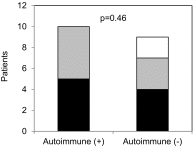Retrospective analysis of the efficacy of omalizumab in chronic refractory urticaria
- PMID: 23998242
- PMCID: PMC3753597
- DOI: 10.2500/aap.2013.34.3694
Retrospective analysis of the efficacy of omalizumab in chronic refractory urticaria
Abstract
Omalizumab has been shown to be effective in chronic urticaria (CU) patients in numerous reports. However, it remains unknown whether there are specific phenotypes of CU that are more responsive to omalizumab therapy. We sought to identify CU phenotypes responsive to treatment with omalizumab by characterizing patients and their response patterns. A retrospective chart review analysis of refractory CU patients unresponsive to high-dose H1-blockers and immunomodulators and subsequently treated with omalizumab at the University of Wisconsin Allergy Clinic was performed with particular focus on their autoimmune characteristics, response to therapy, and dosing parameters. We analyzed 19 refractory CU patients (16 patients failed or had toxic side effects to immunomodulators) treated with omalizumab with an overall response rate of 89% (17/19). Of these 19 patients, 9 patients (47%) had a complete response, 8 patients (42%) had a partial response, and 2 patients (11%) had no response. In comparing the response patterns to omalizumab, we found no statistically significant differences among "autoimmune positive" versus "autoimmune negative" patients. No statistically significant differences in responses were observed when comparing demographic parameters including age, gender, IgE levels, or dosing regimen. Our study shows that omalizumab has robust efficacy in refractory CU patients regardless of their autoimmune status, age, gender, IgE levels, or dosing protocol.
Conflict of interest statement
The authors have no conflicts of interest to declare pertaining to this article
Figures



References
-
- O'Donnell BF, Lawlor F, Simpson J, et al. The impact of chronic urticaria on the quality of life. Br J Dermatol 136:197–201, 1997. - PubMed
-
- Poon E, Seed PT, Greaves MW, Kobza-Black A. The extent and nature of disability in different urticarial conditions. Br J Dermatol 140:667–671, 1999. - PubMed
-
- Hide M, Francis DM, Grattan CE, et al. Autoantibodies against the high-affinity IgE receptor as a cause of histamine release in chronic urticaria. N Engl J Med 328:1599–1604, 1993. - PubMed
-
- Ferrer M, Kinét JP, Kaplan AP. Comparative studies of functional and binding assays for IgG anti-Fc(epsilon)RI(alpha) (alpha-subunit) in chronic urticaria. J Allergy Clin Immunol 101:672–676, 1998. - PubMed
Publication types
MeSH terms
Substances
Grants and funding
LinkOut - more resources
Full Text Sources
Other Literature Sources
Medical

